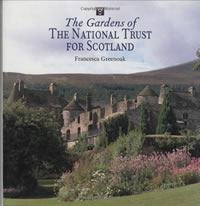 How I wish “The Gardens of The National Trust for Scotland,” by Francesca Greenoak had been available when I visited Scotland gardens, as nearly every garden on my short list was part of the Trust. I would have known before my visit that Inverewe is indeed a rhododendron haven with over 2,000 different types, and that the founder was known as “bigleaf” Osgood for his love of large-leaf rhodies. Greenoak is skilled at teasing out these life-giving facts for her garden descriptions. Of equal importance are the photographs of Brian Chapple. Much more than coffee table filler, his images tell a story, such as the rejuvenation of the massive and ancient yew hedges at Crathes Castle. I gasped at seeing stately walls of green cut back to bare stumps, but subsequent images show the gradual regrowth and restoration of these 300 years old masterpieces. The gardening staff knows their craft!
How I wish “The Gardens of The National Trust for Scotland,” by Francesca Greenoak had been available when I visited Scotland gardens, as nearly every garden on my short list was part of the Trust. I would have known before my visit that Inverewe is indeed a rhododendron haven with over 2,000 different types, and that the founder was known as “bigleaf” Osgood for his love of large-leaf rhodies. Greenoak is skilled at teasing out these life-giving facts for her garden descriptions. Of equal importance are the photographs of Brian Chapple. Much more than coffee table filler, his images tell a story, such as the rejuvenation of the massive and ancient yew hedges at Crathes Castle. I gasped at seeing stately walls of green cut back to bare stumps, but subsequent images show the gradual regrowth and restoration of these 300 years old masterpieces. The gardening staff knows their craft!
Excerpted from the Winter 2008 Arboretum Bulletin.
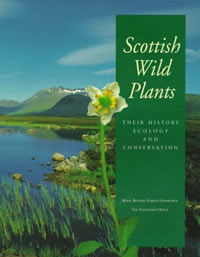 For something to fit in your suitcase when travelling to Scotland, consider “Scottish Wild Plants: Their History, Ecology and Conservation.” Authors Philip Lusby and Jenny Wright skillfully weave into some 40 plant profiles description, habitat, ecological niche, associated plants and animals, natural history, and even something of the history of Scottish botany. This is good reading straight through, yet still useful as a reference work, although you’ll want a pocket field guide, too — there are several good ones in any Scottish bookstore. This book is more for setting the mood. For example, you’ll learn that Primula scotica is one of the few endemic plants in Scotland and its survival is linked to rabbits, an introduced animal to Britain in Roman times. But the relationship isn’t what you’d guess. The Scottish primrose actually thrives best where rabbits are plentiful, as they eat the plants that shade this tiny, post-glacial relic.
For something to fit in your suitcase when travelling to Scotland, consider “Scottish Wild Plants: Their History, Ecology and Conservation.” Authors Philip Lusby and Jenny Wright skillfully weave into some 40 plant profiles description, habitat, ecological niche, associated plants and animals, natural history, and even something of the history of Scottish botany. This is good reading straight through, yet still useful as a reference work, although you’ll want a pocket field guide, too — there are several good ones in any Scottish bookstore. This book is more for setting the mood. For example, you’ll learn that Primula scotica is one of the few endemic plants in Scotland and its survival is linked to rabbits, an introduced animal to Britain in Roman times. But the relationship isn’t what you’d guess. The Scottish primrose actually thrives best where rabbits are plentiful, as they eat the plants that shade this tiny, post-glacial relic.
Excerpted from the Winter 2008 Arboretum Bulletin.
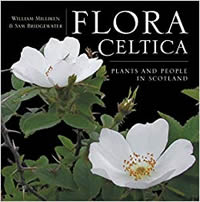 If I could only have one book on Scottish plants, it would be “Flora Celtica: Plants and People in Scotland.” While the main title suggests a comprehensive, taxonomic review of natives, authors William Milliken and Sam Bridgewater instead use ethnobotany as their framework to categorize plants by their impact on humans.
If I could only have one book on Scottish plants, it would be “Flora Celtica: Plants and People in Scotland.” While the main title suggests a comprehensive, taxonomic review of natives, authors William Milliken and Sam Bridgewater instead use ethnobotany as their framework to categorize plants by their impact on humans.
And there is quite a range to this impact. Besides the expected foods, traditional crafts and medicines, this book both looks to the past — recounting much folklore and ceremony — and to the future, exploring the role of plants as we grapple with climate change, restoration and sustainability of resources.
The genius is in the presentation — turn to any page and find fascinating biographies, historical photos and drawings, even poetry and lyrics of traditional songs, all woven around a very readable text. But this is not just about history — the photographs (many by author Milliken) clearly illustrate the landscape and people of today.
“We no longer fumigate our houses with juniper leaves…or tie rowan twigs onto our cows’ tails to ward off the fairies. But we do still…decorate our homes with holly at Christmas and plant marram grass to hold back the sea. And, while some practices are being lost, others are being acquired…” This quote from the introduction captures the spirit of this large, complex, and thoroughly engaging book.
Excerpted from the Winter 2008 Arboretum Bulletin.
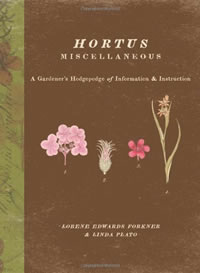 Whimsy, science, puzzles, construction plans, trivia, lists, do-it-yourself instructions — it’s all here in this very hard to describe book. Lorene Edwards Forkner and the late Linda Plato have created a one-of-a-kind book that, like so many other books described in this column, travels well beyond the Pacific Northwest. Turning to a random page, one finds a list of suitable plans for a knot garden, followed by the comparative definitions of monoecious and dioecious, sports teams with horticultural themes (The Fighting Okra?!?), and instructions on how to lay a flagstone pathway. You get the idea.
Whimsy, science, puzzles, construction plans, trivia, lists, do-it-yourself instructions — it’s all here in this very hard to describe book. Lorene Edwards Forkner and the late Linda Plato have created a one-of-a-kind book that, like so many other books described in this column, travels well beyond the Pacific Northwest. Turning to a random page, one finds a list of suitable plans for a knot garden, followed by the comparative definitions of monoecious and dioecious, sports teams with horticultural themes (The Fighting Okra?!?), and instructions on how to lay a flagstone pathway. You get the idea.
Excerpted from the Fall 2007 Arboretum Bulletin.
 The authors of this book were nurtured and informed by the well-known Northwest Perennial Alliance Borders at the Bellevue Botanical Garden. Here, Marty Wingate tells how the Borders are part of a much greater whole brought together by a diverse group of plant lovers. The detailed history is followed by descriptions in word and photo that highlight features and plants in each of the nine gardens, augmented with short profiles of key players. A Garden promotion, yes, but there’s also some good history and enough about the individual plantings to take some ideas home, especially if this book accompanies your next visit to Bellevue.
The authors of this book were nurtured and informed by the well-known Northwest Perennial Alliance Borders at the Bellevue Botanical Garden. Here, Marty Wingate tells how the Borders are part of a much greater whole brought together by a diverse group of plant lovers. The detailed history is followed by descriptions in word and photo that highlight features and plants in each of the nine gardens, augmented with short profiles of key players. A Garden promotion, yes, but there’s also some good history and enough about the individual plantings to take some ideas home, especially if this book accompanies your next visit to Bellevue.
Excerpted from the Fall 2007 Arboretum Bulletin.
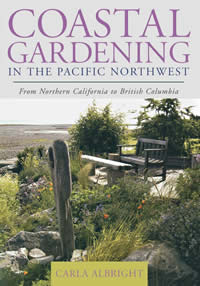 A coastal garden book, this written by a transplanted Pennsylvania Master Gardener, who took the training again in Oregon. Written to a very specific audience, a fact brought home by the second chapter: “Dune Gardening.” Yes, this is for those with lots of sand in their soil. Carla Albright has designed this as a handbook, with many pages of worksheets for the reader to fill out based on experiences. The tips are very basic, too. “In my tool bucket I keep two trowels, a narrow one and a wide one. The narrow one is good for…” Following a review of native beach plants, there are suggestions for appropriate beach garden aesthetics, and an extensive list of shore tested vegetable varieties.
A coastal garden book, this written by a transplanted Pennsylvania Master Gardener, who took the training again in Oregon. Written to a very specific audience, a fact brought home by the second chapter: “Dune Gardening.” Yes, this is for those with lots of sand in their soil. Carla Albright has designed this as a handbook, with many pages of worksheets for the reader to fill out based on experiences. The tips are very basic, too. “In my tool bucket I keep two trowels, a narrow one and a wide one. The narrow one is good for…” Following a review of native beach plants, there are suggestions for appropriate beach garden aesthetics, and an extensive list of shore tested vegetable varieties.
Excerpted from the Fall 2007 Arboretum Bulletin.
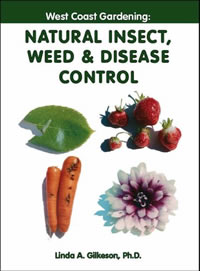 A Salt Spring Island, British Columbia entomologist, Linda Gilkeson is enthralled with the work of beneficial insects in the garden, especially in combating pests. This manual is based on her experience and is very specific to our region. She clearly gives her opinion on what works, and what doesn’t. While the focus is on insects, weeds and diseases get their turn, too. Most of the information is available from other sources, but like many hands-on work, there’s much valuable empirical knowledge. One suggestion caught my eye: planting alyssum amongst gladiolus to attract pirate bugs, who in turn will eliminate the thrips that devastate the glads. It’s worth a try!
A Salt Spring Island, British Columbia entomologist, Linda Gilkeson is enthralled with the work of beneficial insects in the garden, especially in combating pests. This manual is based on her experience and is very specific to our region. She clearly gives her opinion on what works, and what doesn’t. While the focus is on insects, weeds and diseases get their turn, too. Most of the information is available from other sources, but like many hands-on work, there’s much valuable empirical knowledge. One suggestion caught my eye: planting alyssum amongst gladiolus to attract pirate bugs, who in turn will eliminate the thrips that devastate the glads. It’s worth a try!
Excerpted from the Fall 2007 Arboretum Bulletin.
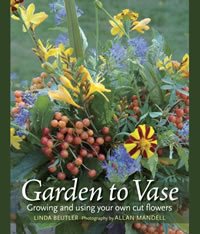 Linda Beutler thinks every gardener should be a florist, at least for his or her own home. On this premise she has written this extensive primer addressing all aspects of filling your vases (or whatever) for any and all occasions. Or for no occasion, other than to better enjoy the bounty of your garden. And the tips are great, such as how to “rinse” your daffodils so they don’t kill the tulips you add to their arrangement. The second half of the book is an A-Z listing the best cutting plants, including growing tips, harvesting tips, vase life, when (or when not) to use preservatives, and what parts of the plant — seeds, flower, leaves, etc. — can be used, either fresh or dried. All this is clearly illustrated with Allan Mandell’s excellent photos.
Linda Beutler thinks every gardener should be a florist, at least for his or her own home. On this premise she has written this extensive primer addressing all aspects of filling your vases (or whatever) for any and all occasions. Or for no occasion, other than to better enjoy the bounty of your garden. And the tips are great, such as how to “rinse” your daffodils so they don’t kill the tulips you add to their arrangement. The second half of the book is an A-Z listing the best cutting plants, including growing tips, harvesting tips, vase life, when (or when not) to use preservatives, and what parts of the plant — seeds, flower, leaves, etc. — can be used, either fresh or dried. All this is clearly illustrated with Allan Mandell’s excellent photos.
Excerpted from the Fall 2007 Arboretum Bulletin.
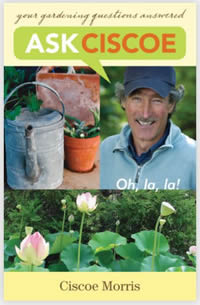 Ciscoe Morris writes like he talks, so you know this book will be fun. Less appreciated is his vast knowledge base that he has acquired from years of experience both as a professional and avid home gardener. That knowledge is presented in a Question (sometimes as funny as the answers) and Answer format, broadly organized into categories such as Flower Plants, Edible Plants, Garden and Lawn Care, etc. Good for the bedside table — to foster ideas as you read as little or as much as you want, or use the excellent index to find a specific topic. There’s much more here — and its all experience based — than first meets the eye.
Ciscoe Morris writes like he talks, so you know this book will be fun. Less appreciated is his vast knowledge base that he has acquired from years of experience both as a professional and avid home gardener. That knowledge is presented in a Question (sometimes as funny as the answers) and Answer format, broadly organized into categories such as Flower Plants, Edible Plants, Garden and Lawn Care, etc. Good for the bedside table — to foster ideas as you read as little or as much as you want, or use the excellent index to find a specific topic. There’s much more here — and its all experience based — than first meets the eye.
Excerpted from the Fall 2007 Arboretum Bulletin.
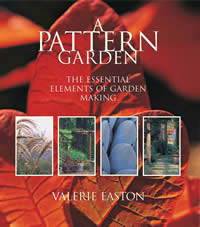 Val Easton’s warm and clear writing style is very familiar, but her subject matter in this book breaks new ground as she applies the architectural concepts of patterns, or putting “human instincts into words,” to garden setting. Throughout she “helps us to understand why we feel comfortable in a space” and why, in other places, we don’t. The patterns are not unfamiliar: Scale, Garden Rooms, Ornamentation, Containers, etc., but some associations may be new, such as grouping Patios, Sheds and Focal Points under destinations. This makes it important to read the book as a whole, even though you’ll return to favorite sections again and again for specifics. A short review of favorite plants concludes the book, but these are just one more pattern in the larger design.
Val Easton’s warm and clear writing style is very familiar, but her subject matter in this book breaks new ground as she applies the architectural concepts of patterns, or putting “human instincts into words,” to garden setting. Throughout she “helps us to understand why we feel comfortable in a space” and why, in other places, we don’t. The patterns are not unfamiliar: Scale, Garden Rooms, Ornamentation, Containers, etc., but some associations may be new, such as grouping Patios, Sheds and Focal Points under destinations. This makes it important to read the book as a whole, even though you’ll return to favorite sections again and again for specifics. A short review of favorite plants concludes the book, but these are just one more pattern in the larger design.
Excerpted from the Fall 2007 Arboretum Bulletin.
 How I wish “The Gardens of The National Trust for Scotland,” by Francesca Greenoak had been available when I visited Scotland gardens, as nearly every garden on my short list was part of the Trust. I would have known before my visit that Inverewe is indeed a rhododendron haven with over 2,000 different types, and that the founder was known as “bigleaf” Osgood for his love of large-leaf rhodies. Greenoak is skilled at teasing out these life-giving facts for her garden descriptions. Of equal importance are the photographs of Brian Chapple. Much more than coffee table filler, his images tell a story, such as the rejuvenation of the massive and ancient yew hedges at Crathes Castle. I gasped at seeing stately walls of green cut back to bare stumps, but subsequent images show the gradual regrowth and restoration of these 300 years old masterpieces. The gardening staff knows their craft!
How I wish “The Gardens of The National Trust for Scotland,” by Francesca Greenoak had been available when I visited Scotland gardens, as nearly every garden on my short list was part of the Trust. I would have known before my visit that Inverewe is indeed a rhododendron haven with over 2,000 different types, and that the founder was known as “bigleaf” Osgood for his love of large-leaf rhodies. Greenoak is skilled at teasing out these life-giving facts for her garden descriptions. Of equal importance are the photographs of Brian Chapple. Much more than coffee table filler, his images tell a story, such as the rejuvenation of the massive and ancient yew hedges at Crathes Castle. I gasped at seeing stately walls of green cut back to bare stumps, but subsequent images show the gradual regrowth and restoration of these 300 years old masterpieces. The gardening staff knows their craft! For something to fit in your suitcase when travelling to Scotland, consider “Scottish Wild Plants: Their History, Ecology and Conservation.” Authors Philip Lusby and Jenny Wright skillfully weave into some 40 plant profiles description, habitat, ecological niche, associated plants and animals, natural history, and even something of the history of Scottish botany. This is good reading straight through, yet still useful as a reference work, although you’ll want a pocket field guide, too — there are several good ones in any Scottish bookstore. This book is more for setting the mood. For example, you’ll learn that Primula scotica is one of the few endemic plants in Scotland and its survival is linked to rabbits, an introduced animal to Britain in Roman times. But the relationship isn’t what you’d guess. The Scottish primrose actually thrives best where rabbits are plentiful, as they eat the plants that shade this tiny, post-glacial relic.
For something to fit in your suitcase when travelling to Scotland, consider “Scottish Wild Plants: Their History, Ecology and Conservation.” Authors Philip Lusby and Jenny Wright skillfully weave into some 40 plant profiles description, habitat, ecological niche, associated plants and animals, natural history, and even something of the history of Scottish botany. This is good reading straight through, yet still useful as a reference work, although you’ll want a pocket field guide, too — there are several good ones in any Scottish bookstore. This book is more for setting the mood. For example, you’ll learn that Primula scotica is one of the few endemic plants in Scotland and its survival is linked to rabbits, an introduced animal to Britain in Roman times. But the relationship isn’t what you’d guess. The Scottish primrose actually thrives best where rabbits are plentiful, as they eat the plants that shade this tiny, post-glacial relic. If I could only have one book on Scottish plants, it would be “Flora Celtica: Plants and People in Scotland.” While the main title suggests a comprehensive, taxonomic review of natives, authors William Milliken and Sam Bridgewater instead use ethnobotany as their framework to categorize plants by their impact on humans.
If I could only have one book on Scottish plants, it would be “Flora Celtica: Plants and People in Scotland.” While the main title suggests a comprehensive, taxonomic review of natives, authors William Milliken and Sam Bridgewater instead use ethnobotany as their framework to categorize plants by their impact on humans. Whimsy, science, puzzles, construction plans, trivia, lists, do-it-yourself instructions — it’s all here in this very hard to describe book. Lorene Edwards Forkner and the late Linda Plato have created a one-of-a-kind book that, like so many other books described in this column, travels well beyond the Pacific Northwest. Turning to a random page, one finds a list of suitable plans for a knot garden, followed by the comparative definitions of monoecious and dioecious, sports teams with horticultural themes (The Fighting Okra?!?), and instructions on how to lay a flagstone pathway. You get the idea.
Whimsy, science, puzzles, construction plans, trivia, lists, do-it-yourself instructions — it’s all here in this very hard to describe book. Lorene Edwards Forkner and the late Linda Plato have created a one-of-a-kind book that, like so many other books described in this column, travels well beyond the Pacific Northwest. Turning to a random page, one finds a list of suitable plans for a knot garden, followed by the comparative definitions of monoecious and dioecious, sports teams with horticultural themes (The Fighting Okra?!?), and instructions on how to lay a flagstone pathway. You get the idea. The authors of this book were nurtured and informed by the well-known Northwest Perennial Alliance Borders at the Bellevue Botanical Garden. Here, Marty Wingate tells how the Borders are part of a much greater whole brought together by a diverse group of plant lovers. The detailed history is followed by descriptions in word and photo that highlight features and plants in each of the nine gardens, augmented with short profiles of key players. A Garden promotion, yes, but there’s also some good history and enough about the individual plantings to take some ideas home, especially if this book accompanies your next visit to Bellevue.
The authors of this book were nurtured and informed by the well-known Northwest Perennial Alliance Borders at the Bellevue Botanical Garden. Here, Marty Wingate tells how the Borders are part of a much greater whole brought together by a diverse group of plant lovers. The detailed history is followed by descriptions in word and photo that highlight features and plants in each of the nine gardens, augmented with short profiles of key players. A Garden promotion, yes, but there’s also some good history and enough about the individual plantings to take some ideas home, especially if this book accompanies your next visit to Bellevue. A coastal garden book, this written by a transplanted Pennsylvania Master Gardener, who took the training again in Oregon. Written to a very specific audience, a fact brought home by the second chapter: “Dune Gardening.” Yes, this is for those with lots of sand in their soil. Carla Albright has designed this as a handbook, with many pages of worksheets for the reader to fill out based on experiences. The tips are very basic, too. “In my tool bucket I keep two trowels, a narrow one and a wide one. The narrow one is good for…” Following a review of native beach plants, there are suggestions for appropriate beach garden aesthetics, and an extensive list of shore tested vegetable varieties.
A coastal garden book, this written by a transplanted Pennsylvania Master Gardener, who took the training again in Oregon. Written to a very specific audience, a fact brought home by the second chapter: “Dune Gardening.” Yes, this is for those with lots of sand in their soil. Carla Albright has designed this as a handbook, with many pages of worksheets for the reader to fill out based on experiences. The tips are very basic, too. “In my tool bucket I keep two trowels, a narrow one and a wide one. The narrow one is good for…” Following a review of native beach plants, there are suggestions for appropriate beach garden aesthetics, and an extensive list of shore tested vegetable varieties. A Salt Spring Island, British Columbia entomologist, Linda Gilkeson is enthralled with the work of beneficial insects in the garden, especially in combating pests. This manual is based on her experience and is very specific to our region. She clearly gives her opinion on what works, and what doesn’t. While the focus is on insects, weeds and diseases get their turn, too. Most of the information is available from other sources, but like many hands-on work, there’s much valuable empirical knowledge. One suggestion caught my eye: planting alyssum amongst gladiolus to attract pirate bugs, who in turn will eliminate the thrips that devastate the glads. It’s worth a try!
A Salt Spring Island, British Columbia entomologist, Linda Gilkeson is enthralled with the work of beneficial insects in the garden, especially in combating pests. This manual is based on her experience and is very specific to our region. She clearly gives her opinion on what works, and what doesn’t. While the focus is on insects, weeds and diseases get their turn, too. Most of the information is available from other sources, but like many hands-on work, there’s much valuable empirical knowledge. One suggestion caught my eye: planting alyssum amongst gladiolus to attract pirate bugs, who in turn will eliminate the thrips that devastate the glads. It’s worth a try! Linda Beutler thinks every gardener should be a florist, at least for his or her own home. On this premise she has written this extensive primer addressing all aspects of filling your vases (or whatever) for any and all occasions. Or for no occasion, other than to better enjoy the bounty of your garden. And the tips are great, such as how to “rinse” your daffodils so they don’t kill the tulips you add to their arrangement. The second half of the book is an A-Z listing the best cutting plants, including growing tips, harvesting tips, vase life, when (or when not) to use preservatives, and what parts of the plant — seeds, flower, leaves, etc. — can be used, either fresh or dried. All this is clearly illustrated with Allan Mandell’s excellent photos.
Linda Beutler thinks every gardener should be a florist, at least for his or her own home. On this premise she has written this extensive primer addressing all aspects of filling your vases (or whatever) for any and all occasions. Or for no occasion, other than to better enjoy the bounty of your garden. And the tips are great, such as how to “rinse” your daffodils so they don’t kill the tulips you add to their arrangement. The second half of the book is an A-Z listing the best cutting plants, including growing tips, harvesting tips, vase life, when (or when not) to use preservatives, and what parts of the plant — seeds, flower, leaves, etc. — can be used, either fresh or dried. All this is clearly illustrated with Allan Mandell’s excellent photos. Ciscoe Morris writes like he talks, so you know this book will be fun. Less appreciated is his vast knowledge base that he has acquired from years of experience both as a professional and avid home gardener. That knowledge is presented in a Question (sometimes as funny as the answers) and Answer format, broadly organized into categories such as Flower Plants, Edible Plants, Garden and Lawn Care, etc. Good for the bedside table — to foster ideas as you read as little or as much as you want, or use the excellent index to find a specific topic. There’s much more here — and its all experience based — than first meets the eye.
Ciscoe Morris writes like he talks, so you know this book will be fun. Less appreciated is his vast knowledge base that he has acquired from years of experience both as a professional and avid home gardener. That knowledge is presented in a Question (sometimes as funny as the answers) and Answer format, broadly organized into categories such as Flower Plants, Edible Plants, Garden and Lawn Care, etc. Good for the bedside table — to foster ideas as you read as little or as much as you want, or use the excellent index to find a specific topic. There’s much more here — and its all experience based — than first meets the eye. Val Easton’s warm and clear writing style is very familiar, but her subject matter in this book breaks new ground as she applies the architectural concepts of patterns, or putting “human instincts into words,” to garden setting. Throughout she “helps us to understand why we feel comfortable in a space” and why, in other places, we don’t. The patterns are not unfamiliar: Scale, Garden Rooms, Ornamentation, Containers, etc., but some associations may be new, such as grouping Patios, Sheds and Focal Points under destinations. This makes it important to read the book as a whole, even though you’ll return to favorite sections again and again for specifics. A short review of favorite plants concludes the book, but these are just one more pattern in the larger design.
Val Easton’s warm and clear writing style is very familiar, but her subject matter in this book breaks new ground as she applies the architectural concepts of patterns, or putting “human instincts into words,” to garden setting. Throughout she “helps us to understand why we feel comfortable in a space” and why, in other places, we don’t. The patterns are not unfamiliar: Scale, Garden Rooms, Ornamentation, Containers, etc., but some associations may be new, such as grouping Patios, Sheds and Focal Points under destinations. This makes it important to read the book as a whole, even though you’ll return to favorite sections again and again for specifics. A short review of favorite plants concludes the book, but these are just one more pattern in the larger design.